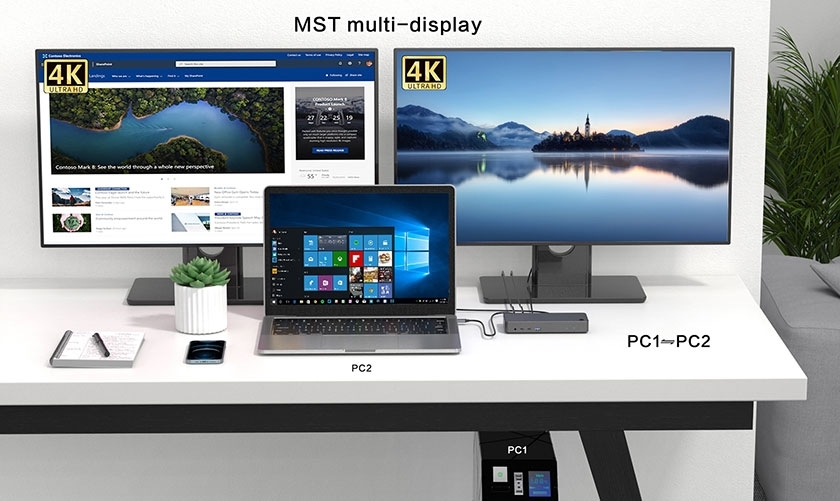MST mode and SST mode are two technical terms frequently brought up within the windows and apple enthusiast communities. We created some visuals to help clear up any confusion of the two protocols.
DisplayPort is the latest display technology on the market and is generally considered to be a competitor to HDMI. The VESA specification, which describes the DisplayPort Technology lists two types of transport modes. The first is SST or Single Stream Transport. The second is MST or Multi-Stream Transport. Below are the main differences.

Multi-Stream Transport Mode is based on DisplayPort technology. MST mode is designed for DisplayPort 1.2 or higher video output specifications. With DisplayPort 1.2, 1.3, and 1.4, you are able to take advantage of MST mode. MST allows you to stream independent video displays from a single desktop or laptop host.
MST hubs and daisy-chain able monitors will enable multiple monitor extended capability. The GPU driver controller takes care of the additional heavy lifting. Two methods of system design can be utilized with MST, MST Hubs or Daisy Chain enabled monitors.

Mirror mode, also called cloning or duplicating your display, in duplicate mode the same image will be displayed on each monitor. Duplicating a display is useful in settings such as retail environments with in-store product promotion screens; arrival and departure boards in airports, bus terminals and train stations; video presentations in classrooms, churches or auditoriums and multiple information booths and kiosks at trade shows. Duplicate mode is backward compatible with DisplayPort 1.1, so it can even be used with many older graphics cards.
In extended mode, the desktop can be extended across multiple monitor displays to utilize maximum workspace. All displays can have different screen resolutions, refresh rates , and screen resolutions (landscape or portrait). You will be able to work on multiple documents at the same time, boosting your productivity. Extended mode is especially useful in presentations when you want to display notes or reference data on one screen while performing a demonstration or showing a video on another screen. Extended mode is the most widely used mode with MST setups.
Creating a video wall lets you combine all monitors in your setup so they act as one giant monitor. You can arrange the monitors however you want them: vertically, horizontally or clustered together. In multi-stream video wall mode, the monitors will correctly display your content to create a dazzling, eye-catching presentation. Create a panoramic digital sign or wow the crowd at your next trade show. Three monitors aligned horizontally also make for a super-wide-screen gaming experience. A computer with a DisplayPort 1.2-compatible graphics card (such as AMD Radeon with AMD Eyefinity technology) is required to display in video wall mode.

Single Stream Transport mode is based on DisplayPort technology. SST mode allows only one external downstream device at a time through a single downstream port. It can however extend the second screen to be mirrored to other monitors. SST is supported on the macOS platforms.
The DisplayPort 1.2 specification includes support for two transport modes: Single-Stream Transport (SST) and Multi-Stream Transport (MST). With the introduction of MST, which combines multiple video signals into a single stream, the default method of transmitting video as a single stream to one monitor was renamed Single-Stream Transport (SST).